Day 2 :
Keynote Forum
Michael F. Herman
Tulane University, USA
Keynote: An approximate semi-classical method that uses real valued trajectories for time dependent tunneling calculations
Time : 09:00-09:25

Biography:
Michael F Herman received his PhD in Theoretical Chemistry from the University of Chicago in 1980. He has been on the Faculty of Tulane University since 1981. His work has focused on the development of semi-classical methods for modeling chemical systems. He also has developed a model for polymer dynamics in the melt, and is studying the influence of intermolecular dipolar couplings between molecular vibrations on isotopic fractionation processes.
Abstract:
A semi-classical method will be presented that describes the time dependent tunneling of a quantum wave packet encountering a barrier. Tunneling through barriers plays a significant role in many reactions. The method described in this talk uses an approximation to the standard semi-classical stationary phase method. The approximation employed in this work leads to real valued tunneling trajectories, while most methods for this problem employ complex valued trajectories. Using only real valued trajectories will have significant advantages in applications to larger systems. It is found that there are typically three of these approximate stationary phase contributions to the wave function for each point r in the transmitted region. Two of these have energies very close to the barrier top, one slightly above the barrier top and the other slightly below it. The third approximate stationary phase contribution is at a lower energy. Difficulties in obtaining accurate values for the contributions from trajectories with energy very close to the barrier top will be considered, and the accuracy of the approximate stationary phase wave function will be discussed.
 Recent publications
Recent publications
1. Herman M F (2015) Semi-classical time dependent tunneling using real trajectories. J. Chem. Phys.143: 164110 (2015).
2. Herman M F (2015) Improving the efficiency of Monte Carlo surface hopping calculations. J. Phys. Chem. B. 118: 8036-8033.
3. Herman M F (2014) Analysis of a surface hopping expansion that includes hops in the classically forbidden regions. Chem. Phys. 443: 12-21.
4. Herman M F (2010) The calculation of multidimensional semiclassical wavefunctions in the forbidden region using Rea; valued coordinates. J. Chem. Phys. 133: 114108.
Keynote Forum
Karl Ulrich Kainer
Helmholtz-Zentrum Geesthacht, Germany
Keynote: Implementation of new magnesium sheets into application from laboratory to service
Time : 09:25-09:50

Biography:
Karl Ulrich Kainer has studied Materials Science from the University of Applied Science Osnabrueck and Clausthal University of Technology. He obtained his PhD degree in Materials Science from Clausthal University of Technology in 1985 and his Habilitation in 1996 on Magnesium Matrix Composites. From 1985 to 1999, he was the Head of the Light Metal, P/M and Composite Group at the Institute for Materials Science and Technology. Since 2000, he is the Director of the Institute of Materials Research and the Magnesium Innovation Centre at Helmholtz-Zentrum Geesthacht and Professor for Materials Technology, Hamburg University of Technology. He has over 30 years of experience working in the area of Light Metals (Al, Mg and MMC’s). He has published more than 320 ISI-listed publications and more than 400 Publications in proceedings and non JCR listed journals. He is member of a number of professional organizations (ASM Int., TMS, German Society of Materials (DGM), Association of German Engineers (VDI) and ASTM Int.) He is Member of the Board of Directors and the Executive Committee of the International Magnesium Association (IMA).
Abstract:
In the recent years, Mg alloys have made inroads into applications in transportation industries. Their favorable property profile like high specific strength, good machinability, recyclability promotes increased usage. Despite magnesium alloys being in service for almost 100 years, there is still a lack of knowledge regarding the potential of Mg alloys. New alloys and new or optimized processes are creating new ideas to substitute traditional materials. However, the implementation of new alloys and advanced processes has many hurdles and hindrances like: Market issues - Price, costs, availability, readiness for market etc.; completeness of the development, unsuitable processes for upscaling from laboratory to industrial scale; inadequate properties after upscaling i.e. strength, ductility, corrosion behavior, crash worthiness; and life cycle assessment issues. In this presentation one example will be discussed: Issues of the implementation of new magnesium sheets for automotive applications.
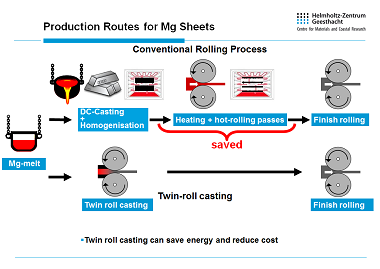
Keynote Forum
Gilbert Daniel Nessim
Bar Ilan University, Israel
Keynote: Towards the growth of 3D forests of carbon nanotubes: Selective height control using reservoirs and overlayers
Time : 09:50-10:15

Biography:
Gilbert Daniel Nessim heads a laboratory at Bar Ilan University (Israel) that focuses on the synthesis of nanostructures using state-of-the-art chemical vapor deposition equipment. The scientific focus is to better understand the complex growth mechanisms of these nanostructures, to possibly functionalize them to tune their properties, and to integrate them into innovative devices. He joined the Faculty of Chemistry at Bar Ilan University in 2010 as a Lecturer and was promoted to a Senior Lecturer in 2014. He holds a PhD in Materials Science and Engineering from the Massachusetts Institute of Technology (MIT), an MBA from INSEAD (France), and Master’s degree in Electrical Engineering from the Politecnico di Milano and from the Ecole Centrale Paris (ECP, within the Erasmus/TIME program
Abstract:
Despite the massive progress achieved in the growth of carbon nanotube (CNT) forests on substrate, besides lithographic patterning of the catalyst, little has been done to selectively (locally) control CNT height. Varying process parameters, gases, catalysts, or overlayer materials uniformly affects CNT height over the whole substrate surface. We will show here how we can locally control CNT height, from no CNTs to up to 4X the nominal CNT height from iron catalyst on alumina underlayer by patterning reservoirs or by using overlayers during annealing or growth. We pioneered the concept of reservoir showing how an iron thin film reservoir placed below the alumina underlayer almost doubles CNT height and how a copper/silver thin film reservoir deactivates the iron catalyst placed above it. We will also show how different thin film reservoir materials can enhance CNT growth by a factor of 4X. We also pioneered the concept of overlayer, where a copper stencil or bridge placed above the catalyst surface during pre-annealing or during CNT growth deactivates the catalyst. We showed how we could pattern regions with CNTs and without CNTs by simply annealing the sample with a patterned overlayer positioned above its surface. Using nickel overlayers, we obtained a similar result but with a completely different mechanism. We thus synthesized patterned CNT forests using a simple process, without the need for lithography. We can now combine the overlayer technique with one of the above-mentioned reservoirs (no reservoir, Cu/Ag reservoir, or Fe reservoir) to further modulate CNT growth by offsetting some or all of the growth enhancements achieved using the reservoirs. This modulation of the CNT height is a significant improvement compared to the "CNTs (one height)/no CNTs" patterning that has been achieved using lithography of the catalyst, and moves us closer to building 3D architectures of CNTs.

Recent Publications
1. Teblum E, Itzhak A, Shawat-Avraham E, Muallem M, Yemini, R, Nessim G D (2016) Differential preheating of hydrocarbon decomposition and water vapor formation shows that single ring aromatic hydrocarbons enhance vertically aligned carbon nanotubes growth. Carbon 109: 727-736.
2. Yemini R, Muallem M, Sharabani, T, Teblum E, Gofer Y, Nessim G D (2016) Patterning of forests of carbon nanotubes (Cnts) using copper overlayers as iron catalyst deactivators. J. Phys. Chem. C 120: 12242-12248.
3. Shawat E, Mor V, Oakes L, Fleger Y, Pint C L, Nessim G D (2014) What is below the support layer affects carbon nanotube growth: An iron catalyst reservoir yields taller nanotube carpets. Nanoscale 6: 1545-1551.
4. Nessim G D, Al-Obeidi A, Grisaru H, Polsen E S, Oliver C R, Zimrin T, Hart A J, Aurbach D, Thompson C V (2012) Synthesis of tall carpets of vertically aligned carbon nanotubes by in situ generation of water vapor through preheating of added oxygen. Carbon 50: 4002-4009.
- Session 1: Nanomaterials | Mechanics, Characterization Techniques and Equipments
Location: Olimpica 1
Chair
Kyuman Cho
Sogang University, South Korea
Co-Chair
Olga Barrera
University of Oxford, UK
Session Introduction
Li Wang
Beijing University of Technology, China
Title: Photoelectron spectra of GexSb20Se80-x Glasses
Time : 10:15-10:35

Biography:
Wang Li is a Professor at the Beijing University of Technology, China. She has her expertise in novel laser with all solid state and nonlinear optics, nanomaterials and technology in improving the optical materials and laser. She has published 130 papers in international journals and conferences of these areas. She is now a member of the SPIE, OSA and the Optical Society of China.
Abstract:
Several GexSb20Se80-x glasses are prepared (x=5, 10, 15, 17.5, 20 and 25 mol%), and measured their Raman and X-ray photoelectron spectra (Ge 3d, Sb 4d and Se 3d) in order to understand the evolution of the glass structure as a function of chemical composition. We further decomposed the spectra into different structural units following the assignments of these structural units in the previous literature. It was found that, Se-Se-Se trimers structural units exists in the Se-rich glasses, but the number of the trimers structural units decreases rapidly with increasing Ge concentration and finally becomes zero in Ge15Sb20Se65 glass. With increasing Ge concentration, the amount of GeSe4/2 tetrahedral structure increases and that of SbSe3/2 pyramidal structure remains almost no changes in the Se-rich glasses. On the other hand, the number of Ge-Ge and Sb-Sb homopolar bonds increases with increasing Ge concentration, and that of the GeSe4/2 tetrahedral and SbSe3/2 pyramidal structures decrease in the Se-poor glasses. Moreover, the Se-Se homopolar bonds exist in all the glasses, and they cannot be completely suppressed. When the composition is close to chemical stoichiometry, the glass is dominated by heteropolar Ge-Se and Sb-Se bonds with negligible amount of Ge-Ge, Sb-Sb and Se-Se homopolar bonds. The transition threshold occurred at the chemically stoichiometric glasses rather than the transition predicted by the topological constraint model suggested that, chemical order rather than topological order is a main factor in determining structure and physical properties of Ge-Sb-Se glasses.
Kazuki Nagashima
IMCE Kyushu University, Japan
Title: Nanocellulose based flexible, environment-friendly nonvolatile resistive switching memory
Time : 10:35-10:55

Biography:
Kazuki Nagashimahas done his PhD and currently is an Assistant Professor in Institute for Materials Chemistry and Engineering, Kyushu University. He received his BSc and MSc in Material Science from Osaka University, and PhD from Osaka University in 2010. He also received the NF Foundation R&D Encouragement Award, Inoue Research Award for Young Scientists in 2013, MNC Young Author’s Award, Sasakawa Young Researcher Award and Funai Foundation Young Researcher Award in 2012. Currently, he focuses on the nanoscale electrical and thermal transport phenomena into one-dimensional metal oxide nanowires and their applications.
Abstract:
Recent rapid development in flexible electronics gives us opportunities for low cost wearable IoT applications, which offers the real time monitoring of individuals’ health status in daily life by taking the information from human body and transferring them from device to device through internet. Although the data should be continuously transferred between devices for realizing real time monitoring, they cannot be obtained if the target human stays under the non-internet environment. In this regard, light-weight, flexible, single-use and disposable nonvolatile memory devices are strongly desired for wearable IoT technology to store the data temporarily even when the target stays under non-internet environment, and to waste them when they finish the role. However, conventional memory devices are not flexible enough and not disposable since they are mostly made of non-renewable, non-biodegradable semiconductor materials and some toxic materials, causing a serious damage for ecological system when they are emitted to environment. Here we demonstrate nanocellulose based flexible and disposable nonvolatile memory. Nanocellulose is renewable and the most abundant biomass on earth, and has outstanding properties including high tensile strength and low thermal expansion coefficient. We first successfully realized the ultra-flexible resistive nonvolatile memory using Ag-decorated nanocellulose paper. The Ag-decorated nanocellulose paper showed the stable nonvolatile memory effects with 6 orders of ON/OFF resistance ratio. The memory performance of nanocellulose paper can be maintained without degradation when being bent down to the radius of 350 mm, which is the smallest value compared to those of existing flexible nonvolatile memories. Second we constructed an environment-friendly, disposable nonvolatile memory device composed of 99.3 vol.% nanocellulose. The device exhibited the biodegradability, which was confirmed by burying it into the natural soil for 26 days. Thus the present device using abundant and mechanically flexible nanocellulose paper offers a highly flexible nonvolatile memory for wearable IoT applications.
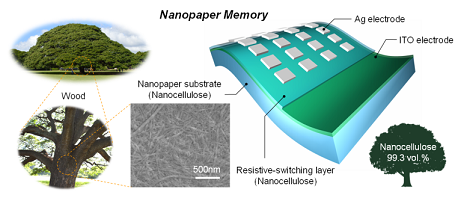
Anna Baldycheva
University of Exeter, UK
Title: 2D material fluid nanocomposites for reconfigurable integrated optoelectronics and Si photonics
Time : 11:20-11:40

Biography:
Anna Baldycheva has completed her BSc from Saint-Petersburg University in 2008 and PhD from the Trinity College Dublin in 2012. She is an Assistant Professor in 2D Optoelectronic Materials at the University of Exeter since 2014, where she is currently leading a highly interdisciplinary research group i.e. Optoelectronic Systems Laboratory. She has extensive expertise in the design, fabrication and testing of integrated Si micro-photonic systems. Since 2011, she has over 50 peer-reviewed publications, invited talks and conference proceedings. She is an Associate Editor of the Nature Scientific Reports and is serving on Board of the Royal Microscopy Society Engineering Section.
Abstract:
Today, innovation of novel reconfigurable materials, which can be integrated on chip with CMOS compatible process and used for engineering devices, is the key driver for realization of future chip-scale multi-functional systems. Among recently emerged optoelectronic materials the fluid-dispersed atomically thin two-dimensional (2D) nanocomposite materials have sparked a great level of interest for their high promise as in-situ tailored meta-material device platform for the next generation of multi-functional (opto)-electronic systems with a wide range of important applications, such as renewable energy, optical communications, bio-chemical sensing, and security and defense technologies. Dynamically controlled three-dimensional self-assembly of suspended 2D liquid exfoliated nano-flakes not only provides a breakthrough route for technological realization of 2D material based 3D device architectures, but also its fluidic nature allows CMOS-compatible back-end integration on chip using microfluidic technology. This opens up almost limitless possibilities in the fabrication of compact and low-power systems for the realization of commercially viable, miniaturized, multi-functional light-management devices, for example light sources, tuneable optical filters and nano-antenna phased arrays. We will demonstrate the possibility to low-power controllable manipulation of 2D nano objects directly on chip utilizing fundamental tuning approaches in Si photonics: electro-optic and thermo-optic effects, as well as discuss the first practicable 2D fluid composite based device designs for application in integrated photonics. We will further focus on the dynamics of 2D nano platelets spatial alignment, understanding of which is essential for the first practicable realization of three-dimensional met structure formation on-chip. Through the optimization of the SOI (silicon-on-insulator) based optofluidic system design to enable simultaneous in-situ Raman spectroscopy monitoring of 2D dispersed flakes during the device operation we have successfully demonstrated possibility for the first time a label-free 2D flake detection via selective enhancement of the Stokes Raman signal at given wavelengths. This approach has then been applied to monitor the individual 2D nano platelets in dynamics within a microfluidic channel on chip during application of external stimuli. We discovered ultra-high signal sensitivity to the xyz alignment of 2D flakes within the opto-fluidic channel, which in turn enables precise in-situ alignment detection for the first practicable realization of 3D photonic microstructure shaping based on 2D-fluid composites and CMOS photonics platform.
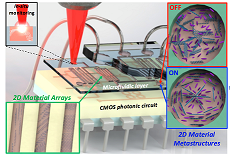
Penny Govender
University of Johannesburg, South Africa
Title: Supporting titanium on silica, graphene, epoxy graphene and carbon nanotubes: A first-principles study
Time : 11:40-12:00

Biography:
Penny P Govender is a Senior Lecturer in the Department of Applied Chemistry, University of Johannesburg. She received her PhD in 2013 from the University of the Witwatersrand, South Africa. She has extensive experience in academia and is currently the Molecular Modelling Group Leader and Head of Department of Applied Chemistry. Her research areas include bioinorganic, computational chemistry, numerical modeling, quantum chemistry and material science. She has published papers in high-impact journals and has presented her work on both national and international platforms.
Abstract:
The use of silica has been studied as a support material with other materials. Since the establishment of ballistic transport and electrical properties of graphene, several researches have been conducted on the interaction between graphene and silica. However, incorporation of TiO2 on graphene-silica resulted in a memristor based on the titanium oxide films and titanium nitride electrode. Enhance textual properties of multi-walled carbon nanotubes (CNTs) with a high loading when TiO2 is supported on multi-walled carbon nanotubes and SBA-15 is revealed. To understand the origin of the electron transfer during photocatalysis, a projected density of state is conducted to assess the orbital contribution in the charge transfer and the effect of introducing TiO2.All the calculations are performed using density functional theory, with the generalized gradient approximation parameterization of Perdew-Burke-Ernzerhof functional as implemented in Cambridge Serial Total Energy Package of Material Studio 2016. To simulate the interfacial and optical properties of the composite material, the powder diffraction patterns and Raman spectra for the starting structural models, as well as pure TiO2, graphene and epoxy graphene monoxide are computed. The electronic and optical properties analysis of the epoxy-graphene monoxide and graphene composites are found to be more sensitive in the visible region (400 to 800 nm) compared to the TiO2, SiO2, and graphene and epoxy graphene monoxide monolayers. The electrostatic potential of the composites is reduced compared to the individual monolayers, which indicates effective electron transfer. Therefore, the new composite material is superior in properties and would find applications in TiO2-based photocatalyst material by exploiting the advantages of other materials.
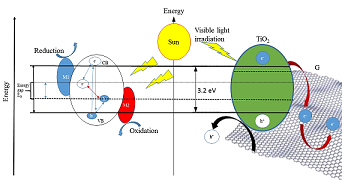
Maria Richetta
University of Rome “Tor Vergataâ€, Italy
Title: Nanostructure Layered Double Hydroxides (LDH): synthesis, characterization and possible applications
Time : 12:00-12:20

Biography:
Maria Richetta has a specific expertise in laser and laser applications for the treatment and preparation of materials. Particular attention has been paid to the study of nanostructured materials. During the last years she has been involved in the characterization of different materials, in particular innovative metallic alloys, through other technique such as XPS, AES, SEM, TEM, XRD and Mechanical Spectroscopy.
Abstract:
Layered double hydroxides (LDHs) are ionic lamellar materials belonging to the group of anionic clays. The structure of LDHs is based on brucite-like layers containing a divalent M2+ cation coordinated with six OH- hydroxyl groups. The substitution of the M2+ metal, with a trivalent M3+ cation, gives rise to the infinite repetition of positively charged sheets (lamellas) alternating with An-ions. The layered structure has attracted increasing interest, because it can host complex organic molecules, intercalated in the interlamellar space. Engineered LDHS can find a wide variety of applications. For instance, they have been investigated as additives in anticorrosion coatings, in flame-retardants, for water treatment and purification, or for biomedical applications like drug delivery and biosensors. Several techniques can prepare LDHs crystallites as: simple one-step hydrothermal process at room temperature;co-precipitation; ion exchange; memory effect reconstruction. To characterize those materials various methods can be applied: from X-ray diffraction to X-ray Photoemission Spectroscopy and Auger Electron Spectroscopy. In the present work we will describe the LDHs samples, obtained in our laboratories, varying the growth parameters, with different substrates and on different layers. We will describe the growth of the structure either on biosensors or on circuit, and the intercalation into the nanostructure of biological molecules. The possible correlated applications as gas sensors, drug delivery systems, nanostructured-modified textile, etc. were also been shown
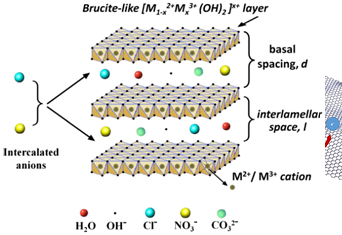
Annivar Ryan
DOST-FPRDI, Philiphines
Title: Nanocrystalline cellulose from abaca fibers
Time : 12:20-12:40

Biography:
Anniver Ryan P Lapuz is a Materials Science and Chemical Engineer. His topic of interest is to explore the potential of nanocellulose from locally abundant agro-lignocellulosic materials. His researches on green composites such as fiber reinforced thermoplastic starch as substitute for single use packaging would further be enhanced using nanotechnology to improve its mechanical and physical properties. His current studies include reinforced thermoplastic starch (TPS) used for thin film and expanded TPS applications.
Abstract:
Nanocellulose is an emerging nanomaterial that is sustainable, renewable, biodegradable and biocompatible. This material can be used for health and green composites applications such as reinforcement materials for high performance nanocomposites, pharmaceutical, chemical and food additives, optically reflective films, high durability varnishes and innovative bio-plastics. Abaca or Manila hemp is one of the most abundant endemic lignocellulosic agro-based fibres in the Philippines which can be an excellent source of nanocellulose. At present, its applications are still limited to cordages, textile, and handicrafts. This study aims to determine the characteristics of nanocrystalline cellulose (NCC) extracted from a disease resistant hybrid variety of abaca fibre that can be used as reinforcement fillers in composite applications. Hybrid abaca fibers were soda pulped and subsequently bleached using HEHEH sequence. Chemical properties of bleached hybrid abaca pulp were comparable with commercial abaca varieties. Different hydrolysis conditions were used to extract NCC from bleached abaca pulp. Acid hydrolysis at 64% sulfuric acid concentration showed that almost all the cellulose has been degraded as observed from the low yield in solid suspension and a brown to dark brown coloration at different reaction time. In contrast, a white cloudy suspension was observed at lower acid concentrations. Chemical and physical processes were conducted to isolate the nanocrystalline cellulose of different acid concentrations acid resulting in a hazy white solution. Among the various acid concentrations, a particle size distribution profile of 23.38 nm using dynamic light scattering technique (Figure 1) was observed from the hydrolysis of abaca pulp at 55% acid concentration reacted for 60 minutes. In addition, a 15% NCC yield with a 0.4% NCC concentration was obtained from the hydrolysis of abaca pulp.

Kyuman Cho
Sogang University, South Korea
Title: A high resolution, multi-purpose scanning I/Q-interferometer scheme for material diagnostics
Time : 12:40-13:00

Biography:
Kyuman Cho has expertise in precision measurements using various interferometer schemes. He has been performing extensive researches in developing interferometric approaches in many high sensitivity applications sensors such as a scanning microscopy for characterization of optical properties of surfaces and materials, readout sensor for reaction monitoring on a biochip, long range vibrometer, and many other applications. He has been also working on diagnostics of the magnetically confined plasma in KSTAR, the fusion reactor project in South Korea. He is a Professor of Physics at Sogang University since 1992. He has been a Visiting Professor in the Department of Electrical and Computer Engineering, University of Maryland, USA and at the Institute of Cosmic Ray and Radiation, University of Tokyo, Japan. He is a Collaborator for KAGRA, a cryogenic gravitational wave antenna, being built in Kamioka, Japan
Abstract:
An I/Q-interferometer (IQI) scheme is ideal for both macro and micro-resolution diagnostics of various materials and devices, because it can measure the amplitude and phase change induced on the probe beam (PB) by the linear or nonlinear interaction with the sample under test. We recently proposed the new IQI scheme in which the PB and the reference beam (RB) in the interferometer are geometrically balanced as shown in the image. This arrangement is particularly advantageous in the application of the scanning microscopy because the IQI is not susceptible to any noise caused by lateral and transverse motions of the stage during the scanning. Various applications of the scanning IQI on the material diagnostics have been studied. The interferometer can provide the map of the local variations of the complex reflectance of the surface if the sample is reflective while the map of the local variations of the complex refractive indices can be obtained if the sample is transparent. In the latter case, the sample is mounted on a mirror which reflects the PB back into the interferometer. In the case of reflection measurements, images representing variations of the local topography and material inhomogeneity of the surface under test can be obtained by mapping point-to-point changes of the phase and amplitude values of the PB during the scanning. In the case of transmission measurements, the analysis may be more complicated, but, in principle, the amplitude and phase of the PB are determined by the absorption coefficient and optical thickness of the sample under test. In this presentation, details about the scanning IQI and its applications will be discussed.
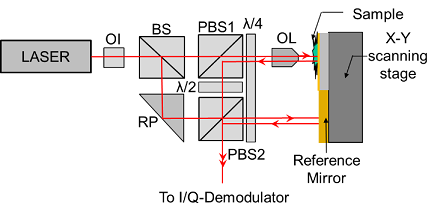
Olga Barrera
University of Oxford, UK
Title: Coupling diffusion and mechanics modeling for hydrogen embrittlement (HE)
Time : 13:00-13:20

Biography:
Olga Barrera is a Senior Researcher Associate at the University of Oxford. Her expertise is in the field of computational mechanics and computational material modeling. Her research focuses on solving a range of coupled diffusion mechanics problems focused on understanding the failure process of a number of material systems. She also has experience in applying the wide range of skills developed in the fields of materials modeling and computational solid mechanics to solve exciting and important problems in parallel disciplines such as biomechanics.
Abstract:
This work deals with modeling HE mechanisms in high strength steels. The aim is to elucidate two failure mechanisms in the presence of hydrogen: Hydrogen induced local plasticity (HELP) and hydrogen induced decohesion (HID). The HELP theory suggests that hydrogen, in contrast to the usual understanding of embrittlement, enhances the dislocation mobility and promotes slip localization, resulting in localized plastic failure. Furthermore, hydrogen reduces the bonding energy between atoms leading to decohesion. The HID mechanism might explain the brittle intergranular fracture surface observed in high strength steels. Experimental evidence of the occurrence of HELP versus HID or, more probably, their synergetic effect, is still an unresolved issue. Hydrogen atoms can accumulate, either within the matrix or at interfaces (i.e., between particles and the surrounding matrix, or grain boundaries) affecting the mechanical response of the material. We construct a finite element model in order to simulate the mechanical behavior of the matrix and interface coupled with hydrogen transport. We also include simple kinetic models of the flux of atoms into (and out of) an interface. We combine this understanding with micromechanical models of the interaction of dislocations with particles and with empirical models of the effect of hydrogen on interface decohesion and plastic deformation to provide a set of coupled constitutive equations for hydrogen transport and mechanical behavior. With this modeling framework, we aim to identify and explore the conditions under which HELP or HID or both mechanisms are activated. In particular, we model the failure of high strength steels which contain a distribution of nano-scale particles. We simulate the response in hydrogen and hydrogen-free environments and identify the conditions under which hydrogen can lead to: (a) a quasi-brittle macroscopic response through localization of plastic deformation facilitated by decohesion at the particle/matrix interface or (b) a brittle intergranular fracture process.

Jérôme Colin
University of Poitiers, France
Title: Effects of plasticity and pressure on the morphology and propagation of blisters: formation of croissant and donut-like buckles
Time : 14:00-14:20

Biography:
Jérôme Colin works in the field of the Mechanics of Materials and Materials Science. He is involved in the modeling of the mechanical properties of nano-structured materials, thin films on substrates and coatings. More precisely, he has constructed models in the framework of the elasticity and thermodynamics theories, to characterize the morphological evolution of layers under strain, the formation of atomic defects such as dislocations in strained nanostructures or the delamination and buckling of thin films on substrates.
Abstract:
In a first part, the formation of donut and croissant-like buckles that have been observed onto the free-surface of strained gold thin films deposited on silicon substrates (see figure 1) has been studied from a static point of view by means of finite element simulations. Taking into account the combined effects of the atmospheric pressure applying onto the upper free-surface of the films and of the plastic folding at the circumference of the blisters, the different morphologies of the buckles have been explained. A “shape” diagram for the buckles has been provided as a function of the pressure and of the internal compression strain. The shape and width of the blisters numerically obtained and experimentally observed have been finally analyzed and have been found to match (see figure 2). In the second part, the propagation of the buckles appearing onto the surface of the gold thin films on silicon substrates has been investigated from a dynamical point of view, in the case where atomic steps are present at the film-substrate interface. Although it has only been experimentally observed that the buckles always propagate along the steps on the surface of gold films, the conditions on the internal compression strain in the films, the orientation of the steps with respect to the buckles and the step heights have been determined for the step crossing or step following phenomena. A “propagation” diagram is finally provided versus the angle a between the steps and the compression strain and the step height H
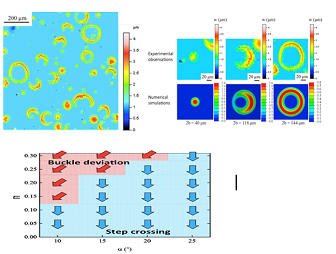
Christine Frayret
Université de Picardie Jules Verne, France
Title: Rational design of organic electrode materials: New advances and tools
Time : 14:20-14:40

Biography:
Christine Frayret is an Associate Professor and has done her PhD degree from the University of Bordeaux 1, Institute of the Chemistry of Condensed Matter from Bordeaux (ICMCB, CNRS UPR 9048) France. She was mainly involved in the area of solid electrolytes/electrodes for fuel cells and luminescence of materials. She then joined the Laboratory of Reactivity and Chemistry of Solids at University of Picardie Jules Verne (LRCS, CNRS UMR 7314, Amiens, France), where she started to focus on battery materials. Her most recent work addresses determination of structure-property relationships, identification of guidelines for the design of energy related materials, especially for the potential next generation storage devices involving novel more eco-friendly organic electrodes and investigations on photochromic materials.
Abstract:
The demand for sustainable energy sources has stimulated great interest in new technologies and materials. A multitude of research efforts in recent years have led to marked progress in this area, including in particular lithium-ion batteries based on organic electrodes. A significant milestone in designing such materials would correspond to the comprehension of the rules governing the increase/decrease of the redox potential of molecular entities, especially if differentiation between various backbones/functional groups/redox centers or incidence of atom substitution within rings can be reached. Based on the combined use of molecular quantum simulation and accurate examination of the electronic structure properties, a rational design of organic electrode materials can be performed. In addition to spin density populations’ estimation, different additional tools can be used to understand molecular redox potential trends. For instance, NICS (nuclear independent chemical shift), HOMA (harmonic oscillator model of aromaticity), d FLU indicators, etc., have the opportunity to electron delocalization on various rings/bond paths within a molecule in a quantitative way. In this context, the partitioning of the global energy of the molecule may constitute another analysis instrument to shed light on the various pieces of molecule playing the main role in stabilization/destabilization upon reduction or how balance between some competitive effects does occur. Such approach can be applied to systematic theoretical screening of existing compounds/hypothetical novel candidates, both being tuned through various effects. This should progressively complete the database for the discovery of new/optimized organic electrodes with improved features. Thanks to this methodology a work of prospection has been undertaken on various families, including derivatives of quinone, carboxylate, quinoneazine and pentalenedione. By focusing on these various sets of compounds, we identified some property-based guidelines, which may serve not only for the ranking of the studied entities but also for the search of more advanced systems.
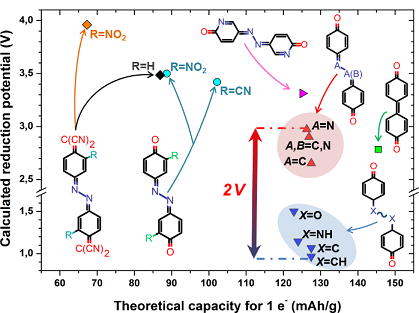
Natalie German
Technical University of Munich, Germany
Title: Computational investigation of the kneading process of bread dough
Time : 14:40-15:00

Biography:
N Germann research group focuses on the rheology, i.e., the flow behavior, of viscoelastic fluids that are of industrial relevance. The reason for the unusual rheological properties of viscoelastic fluids is their microstructural dynamics. To establish a more fundamental understanding of viscoelastic fluids, her research group investigates the relationship between their rheology and their microstructure. The research approach combines thermodynamic modeling and numerical simulation with laboratory experiments.
Abstract:
A key step in the production of bread is the kneading process. The aim of this process is to form the gluten network and to bring air into the dough. While too little kneading results in dough with limited gas storage capacity, too much kneading can destroy the gluten network, impairing the dough’s ability to rise. There is a connection between the rheological properties of kneaded dough and the final quality of bread. Since scientific basis is lacking, the industrial kneading process is currently controlled using visual and haptic information from experienced personnel. Therefore, the goal of this project is to investigate the kneading process using CFD. For the rheological description of the dough, we used a new model developed by Tanner et al. (2011). We determined the exact values of the model parameters by fitting the model to small amplitude oscillatory shear, stress relaxation, transient simple shear, and uniaxial compression data. In the dough model, a so-called damage function is used to describe the partial degradation of the starch and the proteins during the deformation. We have slightly modified this function to prevent a drastic decrease in the moderate deformation range. With the help of this modification, we obtained an excellent agreement with the experimental data (see Fig. 1). Due to its complexity, the dough model has not yet been solved for an inhomogeneous flow field. In this talk, we will present the first results of such a simulation, performed in the annular gap between two eccentric cylinders. This benchmark geometry is an idealized form of a kneader. We will discuss the numerical solution strategy that we have implemented in OpenFOAM. A further focus will be the relative influence of the rotational speed on the shear and extensional deformations.
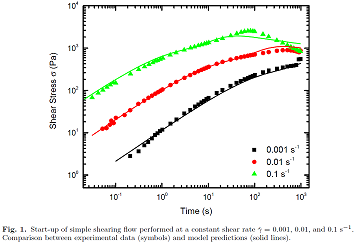
Aitor Larrañaga Varga
University of the Basque Country, Spain
Title: Materials characterization by X-ray diffraction techniques
Time : 15:00-15:20

Biography:
PhD from the University of the Basque Country in 2005 in Materials Science concerning Transition Metal Selenites. Researcher in Materials Crystallography 01/04/2005-03/07/2007, Advanced Technician, General Research Services 03/07/2007- present. Specialization in material characterization techniques and results analysis. X-ray diffraction; not environment measurements, size-strain, quantification, full profile analysis, texture, stress, orientation, grazing incident, micro-diffraction. Material and components, structure optimization. Synthesis and study of new materials with technological applications. Structure-property relationships. More than 50 international Publications (ISI Web of Knowledge), 3 books chapters, more than 90 conference Communications. Participation in national (7), Basque Government (8) and University (2) research projects. Supervision of PhD thesis (2015), next lecture PhD thesis 2018. More than 10 given courses focused on X-Ray Diffraction, participation in Master and Doctoral School since 2007/08. Assistance to more than 60 courses or training sessions related with materials research and teaching.
Abstract:
Integrated in the General Research Services of the University of the Basque Country, UPV/EHU, the X-ray Unit, provides the possibility to study single crystals, polycrystalline samples or amorphous materials, under a wide range of conditions. The available equipment enables structural studies starting from diffraction data of polycrystalline materials. This technique allows us to identify the crystalline phases presented in the samples, crystal size estimation, size/strain analysis, particle morphology or structural mean parameters study. The full profile simulation could give us all the structural information, perhaps compositional results and quantitative analysis of materials. In the other hand different equipments and configuration implemented in the service give us the possibility to; make high and low temperature measurements, layer thickness calculations, obtain deepness gradient information, texture analysis, stress measurements, crystal orientation, micro-diffraction, etc. The X-Ray Service supports basic and applied research through scientific and technical advice and the use of a high-performance infrastructure in materials analysis with applications in many areas of knowledge.
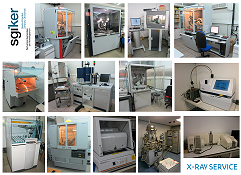
Ebru Saraloglu Güler
Baskent University, Turkey
Title: Internal stress and friction measurements during MoS2-nickel electrodeposition
Time : 15:20-15:40

Biography:
Ebru Saraloglu Güler is an Assistant Professor in the Department of Mechanical Engineering at the Baskent University in Ankara, Turkey. She received her BSc and MSc degrees from the Middle East Technical University, Turkey in 2006 and 2008, respectively. She got her PhD degree from Metallurgical and Materials Engineering Department of Middle East Technical University in 2013. Her main interests are phase electroplating and composite materials.
Abstract:
The electroplating method is a promising alternative to produce composite plating by using dispersed fine particles in the metal plating bath. The process can be either called electro co-deposition or composite deposition. The particles are trapped in the deposit during the process. Internal stress is a common problem in plated deposits that affect the performance of the coatings and may even result in adhesion problems. Hence, the amount and type (compressive or tensile) of the internal stress must be controlled. MoS2 particle-nickel coatings can be referred as self-lubricating coatings that satisfy the demand for decreased friction in severe applications. The internal stress during MoS2 particle-nickel electrodeposition was measured by deposit stress analyzer. The effects of electroplating parameters that are MoS2 particle concentration (0 and 10 g/l), temperature and coating thickness (25 and 50 µm) on the internal stress values were investigated by Taguchi design. It is found that increasing MoS2 particle concentration and coating thickness led to decrease in the internal stress developed during MoS2-nickel composite coatings. Interaction effects of these parameters were also revealed. The most effective parameter on internal stress was determined as MoS2 concentration by regression analysis. Therefore, three different MoS2 concentrations (0, 10 and 30 g/l) were studied in order to find out the concentration effect on the coefficient of friction and wear rate by pin-on-disc tribometer.
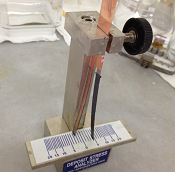
Juhwan Lim
Agency for Defense Development, South Korea
Title: In-situ measurement for ablation geometry during impinging of plume with laser triangulation method
Time : 15:40-16:00

Biography:
Juhwan Lim has his expertise in carbon material, from nano-sized graphene to macro size carbon/carbon composite. He did his BS (2011) and MS (2013) in the Department of Mechanical Engineering from Yonsei University, Seoul, South Korea. His major field of study is synthesis, device fabrication, and optoelectrical property characterization of graphene, graphene oxide and relating nano-composites. Currently, he is a Researcher at the Agency for Defense Development. He has published 16 papers in international journal, including Journal of Physical Chemistry-C, Carbon, Journal of Materials Chemistry and Scientific Reports. Currently, his research also focuses on designing, testing and characterization of anti-ablation and thermal protection composite materials such as C/C, G/P and other FRP composites for applying it to advanced thermal protection system.
Abstract:
In-situ ablation measurement of glass phenolic (G/P) composite during hot plume impinging was studied using laser triangular method. G/P, a representative anti-ablative material has been studied for its application in aerospace, automobile, and defense area. Especially, the ablation mechanism by aerodynamic heating has been well studied with various measurement methods for developing accurate computational model. However, when G/P is required to resist impinging plume, such as plume resistance plate in vertical launching system, different ablation behavior exhibits which demands another investigations for this mechanism and computational model. Therefore, in-situ measurement method for proving mechanism and developing computation model of ablation with impinging plume of high pressure and temperature is highly required. The G/P composite, a suitable material for resisting impinging plume from rocket nozzle, was tested its ablative characteristic using small-scaled booster with 16% concentration of alumina particle. The plume impinged vertically to material surface with about two seconds. During the test, real-time measurement of ablation geometry was conducted with laser triangular method, using laser wavelength of 405 nm and laser intensity of 0.44 W. The laser spots were spread on material surface by diffractive optical elements, and monitored using high-speed camera. The laser signal was distinguishable even in the atmosphere of existing hot plume by installing optical filter, and the movement of laser spots during the test was monitored and calculated to ablation rate. The transient section of combustion and radiation of hot plume occasionally shaded the laser, while the highest precision level of real-time recession measurement confirmed. Moreover, the high accuracy of this method has been proved via comparing with thermocouple signal and geometry scanning after the test. We believe this method, which firstly conducted with highest accuracy and stability, showed its high potential for broaden research of anti-ablative materials.
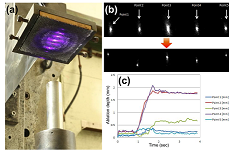
Zahoor Ahmad
Kuwait University, Kuwait
Title: Chemically bonded aramid-MWCNTs nano-composites: Morphology and thermal-mechanical properties
Time : 16:25-16:45

Biography:
Z Ahmad is working on Polymeric Nano-Composite Materials. He is a Professor in Kuwait University. He did his PhD from Manchester University, UK in1978 and Post-doctoral work from the Institute of Mechanical Process Engineering and Mechanics, Germany. He was a Senior Fellow in the Polymer Research Center, University of Cincinnati, USA and has worked as a Visiting Professor in the Saarland University and in the Max Planck Institute for Polymer Research, Germany.
Abstract:
Aramid-multiwalled carbon nanotubes (Ar-MWCNT) nano-composites using functionalized and pristine CNTs with different loadings have been prepared. High molecular weight amine terminated aramid chains were prepared by the reaction of mixture of meta- and para-phenylene diamines with terephthaloyl chloride in the solvent dimethylacetamide. These chains were linked chemically with the acid-functionalized MWCNTs. Thin composites films with different MWCNT loadings were prepared by the solvent elution technique. The effect of interfacial interaction on the composite morphology was investigated by scanning electron microscope (SEM). Dynamic thermal mechanical analysis (DMTA) showed a higher increase in the storage modulus and the temperature involving α-relaxations on CNTs loading in comparison to the system where pristine CNTs were used. The depression in the tan delta peak indicates the polymer material in composite material participating in the glass transition was reduced on loading with the MWCNT. The maximum tensile strengths with 7.5 wt% of CNTs were 166.8 MPa. Thermal mechanical analysis showed a drop in coefficient of thermal expansion, prior to glass transition temperature and was reduced to 39.8 ppm/ºC that is consistent with immobilization of polymer material present at the CNT interface. The thermal decomposition temperature of these composites was around 533ºC. Strong interfacial interactions of the matrix with the functionalized CNTs in the composite materials resulted in higher viscoelastic properties and a reduction in the coefficient of thermal expansion of aramid on loading the MWCNTs.
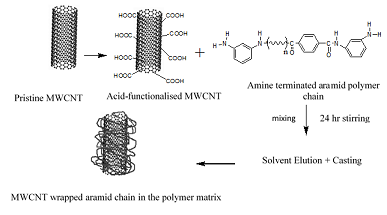
Sandile Simelane
University of Johannesburg, South Africa
Title: The fate, behavior and effect of WO3 nanoparticles on the functionality of an aerobic treatment unit
Time : 16:45-17:00

Biography:
Sandile Simelane obtained his BSc degree from the University of Swaziland (UNISWA), where he majored in chemistry and biological science. Apart from his degree, he also holds certificates in Human resource management, entrepreneurship, and introductory to wastewater treatment. He was then employed by Coca-Cola Swaziland as a Laboratory Chemists for a period of seventeen months. His main role included method validation, equipment troubleshooting and preventatives maintenance and analysis of incoming materials. Whilst employed by Coca-Cola, He was also trained in ISO 17025 by SANAS. Being a person of excellence, and willing to expand his scientific knowledge, Mr. Sandile decided to pursue a higher degree in chemistry. He is currently an MSc Chemistry student at the university of Johannesburg, where his research interest is on understanding the fate and behaviour of engineered nanomaterials
Abstract:
As a promising organic photocatalyst in wastewater treatment, understanding the fate and behavior of the WO3 nanoparticles and its impact on the functionality on the treatment plant is of paramount importance for accurate toxicological risk assessment. This was achieved through acclimatization of activated sludge to the simulated wastewater treatment plant operated according to the Organization for Economic Co-operation and Development 303A guidelines. During acclimatization, chemical oxygen demand (COD), and a five-day biological oxygen demand (BOD5) were monitored. Humic acid impact on the functionality of the domestic waste water treatment plant was investigated as it is a major constituent of wastewaters. The COD removal was above 80% suggesting that humic acid had no impact on the activated sludge activity. The fate of m-WO3 was monitored using X-ray diffraction and scanning electron microscope coupled with electron dispersive x-ray. X-ray diffraction analysis showed presence of m-WO3 in the sludge which was further confirmed with electron dispersive x-ray -mapping which showed presence of tungsten signifying adsorption of the nanoparticles on the sludge. Up-to the addition of 15 ppm WO3 showed to have an effect on functionality of the treatment plant as the COD removal dropped to 70 % which is below the 80% stipulated guideline signifying adequate removal of the COD. This implies that WO3 nanoparticles possess toxicity effects on the activated sludge. An increase in conductivity was observed in the test effluent suggesting the possibility of dissolution of the nanoparticle. The ICP-OES analyses showed that 80% of W was retained in the sludge while 20-21% m/m actually run out with the effluent.

Yu-Ling Guo
National Cheng Kung University, Taiwan
Title: Flexible synthesis of anatase TiO2 nanocrystallines for dye-sensitized solar cells applied at regular sunlight and room light conditions
Time : 17:00-17:15

Biography:
Yu-Ling Guo is pursuing her Master’s degree from National Cheng Kung University, in Resource Engineering. She is doing research with a focus on dye-sensitized solar cells. She has also presented her work at the Annual Meeting of Taiwan Ceramic Society. In addition, she has conducted research on polymer and drug control release and has gained College Student Research Training Fellowship from the National Science Council.
Abstract:
Microwave-assisted solvothermal process was used to synthesize anatase TiO2 nanocrystallines for the application of dye-sensitized solar cells (DSSCs). The morphologies and sizes of TiO2 could be simply controlled by using different kinds of alcohols where no additives were needed. By using isopropanol (IPA) as solvent, TiO2 in size of 20-30 nm with dominant {001}/{010} facets was obtained; whereas ultrafine anatase TiO2 of about 5 nm with dominant {101}-facet was obtained using octanol (OCT). To investigate the influences of TiO2 on the photovoltaic performances of DSSCs, three different pastes were fabricated using IPA, OCT and mixed IPA/OCT as photoanodes. The results revealed that the requirements of TiO2 photoanodes used at one sun and room light conditions were quite different. OCT showed the highest power conversion efficiency (PCE) up to 9.58% under one sun irradiation because of its high specific surface area that provided high dye-loading capacity. However, the great amount of grain boundaries appeared in OCT became disadvantageous at room light condition. On the other hand, IPA/OCT combined the features of IPA and OCT that was optimal for room light harvesting and its PCE reached 12.46% under 200 lux T5 lamp irradiation. The photovoltaic properties of three different photoanodes in correlation with their band structures, electronic transport behaviors and light harvesting efficiency in different lighting conditions will be carefully discussed in this presentation.
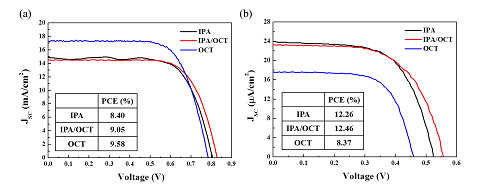
Monalisa Garai
National University of Singapore, Singapore
Title: Single particle spectroscopic studies on two-photon photoluminescence of plasmon coupled gold nanotriangle dimers
Time : 17:15-17:30

Biography:
Monalisa Garai is currently a fourth year PhD student under the supervision of Associate Professor Xu Qing Hua in the Department of Chemistry, NUS. She has done her Master's degree with a specialization in Material Chemistry from the Department of Chemistry, NUS. Before joining NUS, she finished her Bachelor’s degree and Master's degree from the University of Calcutta, India. Her research interests include single particle spectroscopy, plasmonic nanostructures, nonlinear optics and nanophotonics.
Abstract:
Surface plasmon resonance (SPR) coupling between adjacent metal nanoparticles in aggregated nanoclusters results in significant enhancements in many optical responses, such as fluorescence, surface enhanced Raman scattering (SERS) and two-photon photoluminescence (2PPL). Here, 2PPL properties of gold nanotriangle (Au NT) dimers with different spatial arrangements have been investigated on single particle level to understand their different plasmon coupling effects on 2PPL enhancement mechanism and explore the limit of maximum achievable enhancement factor. Compared to NT monomer, scattering spectra of both side-by-side and tip-to-tip coupled NT dimers are red-shifted by 101 nm and 175 nm, respectively with strong polarization dependence along their assembly axis, which can be understood in terms of plasmon hybridization theory. A close resemblance between scattering spectra and 2PPL spectra indicated SPR is the origin of observed 2PPL signal. 2PPL intensities of side-by-side and tip-to-tip dimers are enhanced by 1.0×103 fold and 2.6×104 fold respectively, compared to the NT monomer. Such a huge enhancement in tip-to-tip dimer is a combined effect of plasmon-coupling-induced red-shifted SPR band which has better overlap with the excitation wavelength and giant local electric field amplification due to the presence of sharp tips in inter-particle gap. The influence of sharp tips has been further demonstrated by comparing Au NT monomer and dimers with Au nanosphere (NS) monomer and dimer of similar dimensions. The 2PPL intensity of Au NT monomer is 20 times stronger compared to Au NS monomer, where as that of Au NT tip-to-tip dimer is 93.5 times stronger compared to Au NS dimer. All our experimental results show excellent agreement with numerically calculated integrated |E/E0|4 results. These findings offer a deeper insight in fundamental understanding of plasmon coupling enhanced 2PPL properties and provide a platform for various sensing and imaging applications.

Pietro Cataldi
Italian Institute of Technology, Italy
Title: Fiber networks modified with graphene for durable and versatile flexible electronics
Time : 17:30-17:45

Biography:
Pietro Cataldi is working on the creation of nanocomposites combining plastics and biopolymers with graphene to obtain unconventional multifunctional material. He has completed his Master of Science in Physics in the year 2014. He studied at the University of Genova and at the Berlin Freie University. He has done his Master’s thesis in the Electron Dynamics Group of the Physical Chemistry department at the Fritz Haber Institute of the Max Planck Society. Currently, he is pursuing his PhD in the Smart Materials Group of the Italian Institute of Technology of Genova. He co-authored 5 papers and has participated in four international conferences with an oral contribution.
Abstract:
Flexible and foldable electronic components require materials that can retain their electrical conductivity even after hard mechanical manipulations and multiple folding events. Such a material was realized with two different methods exploiting the combination of all-biodegradable components (substrate and the polymer matrix) and graphene nanoplatelets (GnPs). A fibrous cellulose substrate was sized with a biopolymer-GnPs conductive ink rendering it electrically conductive (sheet resistance ≈10 Ω/sq). The obtained nanocomposite can be used as electrodes for surface electromyography and for terahertz electromagnetic interference shielding. With a similar approach a flexible cotton-GnPs conductive fabric was realized. This material address several drawbacks related to durability and washability of conductive textiles. Micro-cracks formed after repeated folding-unfolding events can be healed through a hot pressing process. Such cotton based conductive composites could find several applications in wearable electronics sector.
Agne KairytÄ—
Vilnius Gediminas Technical University, Lithuania
Title: Mechanical and thermal properties of propylene glycol extended and paper waste sludge modified polyurethane foams
Time : 17:45-18:00

Biography:
AgnÄ— KairytÄ— is a PhD student in Materials Engineering, has participated in national and international conferences as well as projects. Her early researcher career is devoted to the development and research of biopolymers from natural oil-based polyols and ecological as well as energy efficient biopolymer composites from industrial waste. She has knowledge and the problem solving skills essential for performing key areas of technical work as well as quality manager work experience in accredited and notified laboratory of thermal insulating materials.
Abstract:
Polyurethane and polyisocyanurate foams based on vegetable oil polyols are characterised by low thermal stability, high flammability, sensitivity to higher temperatures and lower mechanical performance. The strength may be increased by reducing the cells size, thermal stability and flammability characteristics by using fire retardant materials. There are four species of fire retardants: inorganic fillers, organic phosphorous compounds, nitrogen-based materials, halogenated materials and materials which act as a barrier for flame spread. Organic phosphorous compounds consist of phosphorus and in halogenated materials; carbon forms chains with chlorine and bromine. These fire retardant materials are not biologically degradable and tend to accumulate in the environment. Since halogenated and brominated fire retardant materials are toxic and will not be used in the near future, new ways how to replace such materials with environmentally and to human health friendly materials are of great importance; consequently, in order to improve thermal stability, flammability as well as strength characteristics, organic and inorganic materials or combination thereof are used. Pollution prevention in paper production industry is a worldwide aspiration. One of the main aims of European Commissions and Directives is to transform EU countries into recycling community which is capable of reducing accumulation of waste and using them in different processes. Paper waste sludge is the main and the biggest by-product in paper production process, and its elimination as well as destruction is a primary environmental protection problem. Previous researches have shown that paper waste sludge is porous and its nature – inorganic; however, there is no information on the direct usage in polymeric thermal insulating materials or their composites. The aim of this study is to test paper waste sludge as fire retardant and mechanical properties improving filler in thermally stable polyurethane foam composites from rapeseed oil polyol and water as the sole blowing agent.
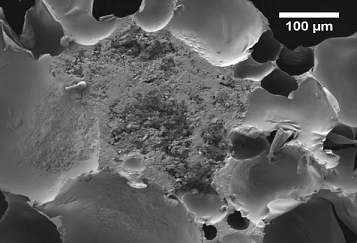
- Session 2: Biomaterials and Medical Devices | Polymer Science and Technology | Ceramics and Composite Materials
Location: Olimpica 3
Chair
Bing Lu
Wanhua Chemical Group Co. Ltd., China
Co-Chair
Loubat Cedric
Specific Polymers, France
Session Introduction
Bing Lu
Wanhua Chemical Group Co. Ltd., China
Title: New development and applications of polyurethane materials
Time : 11:20-11:40

Biography:
Bing Lu is the Director of High Performance Materials Research Center, Wanhua Chemical Group Co. Ltd. He has more than 25 years of research and development experience in the fields of polymer synthesis and products, including olefin polymerization catalysts, olefin polymerization and process, polymer modification and functionalization, polycondensation polymerization, polymer compounding and composites. He is an expert on a variety of plastic materials such as PE, PP, TPO, PBT, PET, PCT, TPEE, POM, CA, LCP, PPS, PEEK, and PU. He has previously worked with Celanese, Formosa Plastics USA, and SINOPEC. He obtained his PhD in Polymer Science from Pennsylvania State University in 1999. He has more than 30 patents and publications.
Abstract:
Polyurethane (PU) materials are versatile with a wide variety of applications. The high demand for lightweight and durable materials from end-use industries such as furniture, construction, electronics and appliances, automotive, footwear and packaging has driven PU growth in recent years. It is projected that the global PU market will reach above USD 105 billion in 2025 from about USD 55 billion in 2016 at a CAGR 7%. The versatility of polyurethanes is highly derived from the wide selection of building blocks available to materials manufacturers. This presentation will review general polyurethane chemistry, polyurethane building blocks and material properties, and further discuss recent development and applications. The growth of polyurethane industries largely depends on the cheap and easily available feedstocks of isocyanates, polyisocyanates, polyols and chain extender co-reactants such as water, alcohols, and amines. The high demand and rapid growth of PU materials in the emerging markets such as China in last two decades has played a significant role in the global PU market, and offered opportunities for petrochemical industry. Wanhua Chemical Group Co. Ltd., in China as one example has emerged and grown as the world top MDI and isocyanates producer. This presentation will also show some of recent development of PU raw materials and products at Wanhua Chemical Group. Some of the new products include PU foams in insulation applications, PU coatings for construction, thermoplastic polyurethane elastomers (TPU), and composites. The future challenges facing polyurethane industry and growth will be also discussed.

Cedric Loubat
Specific Polymers, France
Title: Specific Polymers – Alkoxysilane and phosphonic acid functional groups to improve compatibility between inorganic surfaces and polymers
Time : 11:40-12:00

Biography:
Loubat Cédric has done his PhD degree in Polymer Chemistry from the University of Montpellier, France in 2000. In 2003, He started Specific Polymers Company with the aim to fill a gap between academic and industrial researches in the field of Polymer Chemistry. Currently, he is the Head of Specific Polymers, and the company has 12 employees
Abstract:
Specific Polymers (2003, Castries, France) is a SME with 12 employees acting as R&D service provider and scale up producer in the field of functional monomers and polymers with high specificity. Through its activities, Specific Polymers is involved in scientific research in various application fields like aeronautic, building industry, biomedical area, automotive, green materials or optoelectronic. Even if the research activity of the company mainly focuses on organic polymers based materials, the problems of interaction between organic and inorganic matters have been the subject of numerous studies. Indeed, in most of the cases, the chemical nature of interaction between the inorganic particles and the polymer drives the performance of the resulting system. In this field, Specific Polymers researches are mainly oriented toward (macro) molecules bearing either alkoxysilanes or phosphonated groups. On one hand, polymers bearing alkoxysilane groups are of a great interest for inorganic material surface modification, preparation of functional nanoparticles, or synthesis of sol-gel based hybrid materials. Indeed, the hydroxyl groups located on the inorganic surfaces can react with the alkoxysilanes moieties of functional polymers conducting to hybrid or composite materials exhibiting outstanding properties. On the other hand, phosphonated groups have the ability to bind metal or metal oxides (iron, aluminium, cerium, titanium, uranium, ITO, gadolinium, nickel, copper, zinc, calcium, quantum dots, nano-metals, etc.) and thus can also be used for functionalization of surfaces or particles. As for example, phosphonic acid functionality was often found to be superior to alkoxysilanes moieties for binding inorganic substrates other than silica, because of the higher robustness and stability of metal-OP over metal-OSi bonds. The interest of both alkoxysilane and phosphonated moieties for surface metal or glass surface modifications,1 functionalization of (nano)particles,2,3 compatibilization of inorganic components into polymeric matrix or functional hybrid sol-gel materials in very versatile applications is highlighted.
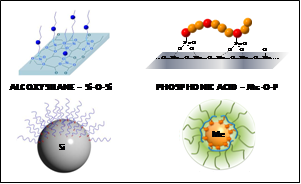
MiloÅ¡ NetopilÃk
Institute of Macromolecular Chemistry, Czech Republic
Title: Improving separation of polymers by size-exclusion and liquid chromatography on the background of the theoretical model
Time : 12:00-12:20

Biography:
Miloš Netopilík has done his Post-graduate studies in Physical Chemistry from Charles University, Prague (1982), PhD (1984) from the Universitas Lucis Spargentis, Wyatt Technology Corporation, Santa Barbara. He was a Research Fellow, Institute of Macromolecular Chemistry, Czechoslovak Academy of Sciences, Prague. In 1998, he was a Senior Research Fellow, Institute of Macromolecular Chemistry, Czechoslovak Academy of Sciences, Czech Republic.
Abstract:
Size exclusion chromatography (SEC) is a widely used method of the separation of polymers according to their size (hydrodynamic radius in the first approximation). The usefulness of the method is increased by benefits of additional detectors (light scattering, viscometer, UV detector) which exploit maximum information about the sample (hyphenated methods). The basic functioning of chromatographic separation can be described by a relatively simple mechanism of establishing equilibrium on each of theoretical plates followed by a shift of the mobile phase by the size of the plate. The model applies for SEC with the separation driven by entropy as well as for liquid chromatography driven by enthalpy. From this observation chromatographic models ensue. The results of the chromatographic models are the band broadening function. The basic mechanism of separation is accompanied by numerous side effects and mechanisms which depend on conditions of analysis, as flow-rate, influencing the equilibrium, the detector-cell volume, etc. The systematic experimental investigation of analysis of polystyrene standards by size exclusion chromatography evaluated on the background of the plate-height model of separation provides the insight into the mechanism and its efficiency, a measure of reaching equilibrium. For polymers of molecular weight about thirty thousand and higher, the separation improved with decreasing flow-rate is in accord with Giddings observation of transversal diffusion as a factor decreasing the broadening of the band broadening function. The variance of the elution curves is larger than it corresponds to dispersity in molecular weight and the shape of the elution curves depends on the experimental conditions which suggest that it reflects properties of the band broadening function. The skew and the excess kurtosis of the elution curves increases near the exclusion limit in accord with theoretical prediction. The excess kurtosis of the elution curves, obtained by SEC of polystyrene standards in tetrahydrofuran using pumps and UV detector DeltaChrome, and one column PL gel MIXED D is depicted in Figure 1. The points for the lowest flow-rate of 0.01 ml/min fit the theoretical line best.
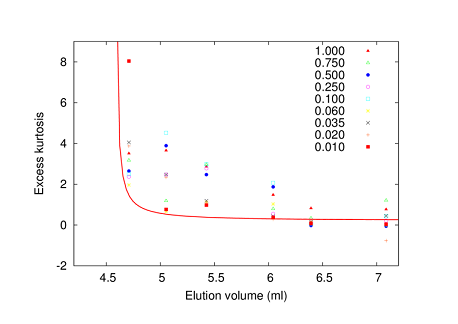
Richard Vendamme
Flemish Institute for Technological Research, Belgium
Title: Sticky degradable bioelastomers
Time : 12:20-12:40

Biography:
Richard Vendamme obtained an engineering degree and a master degree in organic and macromolecular chemistry in Lille (France) in 2001. He subsequently moved to the Max-Planck Institute for Polymer Research (Mainz, Germany) for preparing a Ph.D. dealing with stimuli-responsive liquid crystalline gels. In 2004 he was awarded a JSPS postdoctoral fellowship and started his career at the Institute of Physical and Chemical Research (RIKEN) in Japan, where he notably created a unique class of free-standing nanomembranes. He joined Nitto Denko in late 2007, where his interests extended to various topics such as molecular imprinting, adhesion, green chemistry, sustainability, bio-inspired materials, new business development and the translation of scientific innovations into real-life business cases.
Abstract:
The biological function of natural soft biomaterials is often related to their unique biomechanical properties. For instance, sandcastle worms produce viscous hydrophobic secretions that strongly stick underwater, the adhesiveness of the glue droplets produced by orb-weaving spiders for coating their silk can be explained by the theory of viscoelastic solid, whereas the wing supports of beetles are mechanically very similar to man-made car tires. Synthetic soft biomaterials that mimic some of the elaborated features observed in Nature are attracting the attention of (bio)chemical engineers due to their promising applications in industry, biotechnology and medicine. Among the various classes of materials that have been used to synthesize such substances, polyesters have recently emerged as a versatile and sustainable platform for various reasons (solvent-free synthesis, biodegradability, etc.). In this paper, we investigate the important and often overlooked structure-property relationships underlying the complex viscoelastic and adhesion behaviors of soft polyester elastomers, an emerging class of degradable functional biomaterials and demonstrate that the adhesiveness of these materials can be mainly understood in terms of bulk viscoelastic factors, in contrast to alternative ideas reported in the literature. To that end, we designed a family of poly(isosorbide fatty alkylates) with different molecular architectures and physical aspects (viscous, sticky, rubbery and solid) as model polyester elastomers. Mechanical properties at both small and large strains and adhesion performances have been investigated by various techniques and complemented with theoretical frameworks resulting in the establishment of a new viscoelastic phase diagram depicting generic adhesive archetypes. These results shed some light on the intimate structure of bioelastomers, and notably on the decisive role of a well-adjusted macroscopic cluster of percolated polyester chains for tailoring key biomaterial functions such as elasticity, stickiness, fibrillation and biodegradation. By establishing a bridge between polyester biomaterials and the material science of sticky things, this paper provides robust design principles for diverse functional biomaterials with tailored dissipative characters such as adhesives with tuneable stickiness and degradation profiles, or scaffolds mimicking the non-linear elasticity of soft biological tissues.
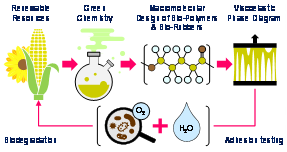
Gerd Kaupp
University of Oldenburg, German
Title: Physics versus non-physical ISO/NIST standards in nano, micro and the numerous macro-techniques are detrimental for daily life: what can be done?
Time : 12:40-13:20

Biography:
Gerd Kaupp has studied Chemistry at the University of Würzburg, Germany and completed Post-doctoral studies at Ames, Iowa, Lausanne, and Freiburg universities, where he became an Associate Professor. He was a Full Professor at the University of Oldenburg in 1982. He served as a Guest Professor for three international universities. He is now a retired member at the University of Oldenburg and pursues his scientific interests also with consulting. His expertise are in chemical kinetics, laser photochemistry, waste-free benign syntheses and productions, solid-state chemistry, reactive milling, atomic force microscopy AFM, scanning near-field optical microscopy SNOM, standardization in nano-mechanics and bionics.
Abstract:
Most mechanical properties of materials are deduced from hardness and elastic modulus. The most used and versatile technique for their detection is indentation mostly with pyramidal/conical diamond tips. ISO-14577 defines and iterates hardness (HISO) and elastic modulus (ErISO) with respect to projected contact area (Ahc=const∙hc2) with (nearly) legal character, but without consideration of the energetics involved (Figure 1), which therefore triply violates basic physics. Still applied older indentation techniques such as Vickers, Knoop, Brinell, Rockwell, and Shore hardness are even more empiric and they include at least the same violations. Nevertheless, they are still widely accepted without trying to develop a sound physical foundation. Thus, the normal force (FN) is not proportional with h2, but with h3/2 as physically founded and experimentally confirmed. The dimensional error for hardness and elastic modulus are clearly violating the first energy law, and the wrong exponent also prevents the detection of phase transitions under load, which requires that only loads below the phase transition onset should be used for material’s characterization. While such onsets mostly occur within the 100 µN range, some require the mN and up to >10 N range, where multiple phase transitions generally occur with the additionally risk of macroscopic cracking (for example NaCl to CsCl-type at 4.233 mN followed by CsCl to CrB-type at 2.49 N without cracking). The way for a physical treatment of indentations has been paved with FN=kh3/2 plots since 1990 (k after energy correction factor 0.8 is the material's penetration resistance), but without appreciation from the establishment despite the most serious flaws including the violation of the energy law: The concomitant shear-force work for building up pressure and plasticizing cannot be assumed to be workless created. The pressure has even been used for the elastic modulus determinations. It does not help that the older very high-force techniques rely on the diameters of the impression surface such as Vickers, Knoop, Brinell (they are convertible into the depths), or that Rockwell and Shore measure depths. Problems with cracks (this does not mean cracks upon reloading for fracture toughness) are not reported but different load ranges distinguished and empirical inter-conversion formulas used. The physically valid HPHYS can now be obtained by linear regression of the loading curve's FN=k h3/2 plots (ErPHYS requires additionally stiffness) without the three flaws (Ref. 11), omitting iterations with simplest arithmetic. It is now valid for all types of materials and all instrumental depth sensing techniques. The dilemma of the ISO standards against physics and thus the “legally enforced” calculation of wrong mechanical properties are detrimental, producing very large errors. Liability problems in case of materials failure ensue. Textbooks and instrument software must be rewritten, the ISO-14577, a NIST tutorial, and numerous publications retracted. Instead, the physical correctness must be installed for the sake of daily life security. Examples will be discussed. ISO appears slow in changing its standards for complying with physics. They are asked to release an urgent caveat, telling that ISO-14577 will be subject to redefinitions for physical reasons.

Ana RamÃrez Ledesma
Instituto de Investigaciones en Materiales, Mexico
Title: Fabrication of Co-Cr alloys for biomedical applications by implementing rapid solidification
Time : 14:00-14:20

Biography:
Ana Ramírez – Ledesma has her expertise in rapid solidification techniques for Co-Cr alloys and Zn based alloys. Her innovative and non – conventional solidification techniques creates a new line of investigation for improving their performance in the biomedical field. Moreover, her collaboration with medical institutions (e. g. National Institute of Cardiology (INC, México, Ciudad de México) will allow the technological development of cardiovascular prosthesis which will be easily accessible for Mexican population. She was awarded with the CONACYT scholarship for doctoral studies and conclude her Ph. D. in the Materials Science and Engineering Program (UNAM) at Materials Research Institute (UNAM). Actually, she has a close collaboration with Dr. Hugo Lopez which is an expert with over 20 years of experience in the field of biomedical grade cobalt based alloys.
Abstract:
Statement of the Problem: It is well known that actually there is a lack of innovation with respect solidification processes on Co-Cr based alloys for biomedical applications (e. g. dental implants and permanent stents). Moreover, the most conventional technique to obtain Co-Cr biomedical devices is the investment casting process. Which involves inherent microstructural defects as a high percentage of interdendritic segregation and several precipitates distributed along the microstructure. All these features results in a decrement of the mechanical properties in Co-Cr alloys used in the biomedical field. Methodology & Theoretical Orientation: High purity cobalt (99.99 %) and chromium (99.99 %) were used as starting metals for processing the experimental Co-Cr alloy. Rapid solidification regime was confirm trough the temperature profile recorded using an Amprobe TMD90A Digital Thermometer with R type thermocouples inserted into a ceramic sheath, embedded in the cooling metal. Findings: Rapid solidification promotes the elimination of interdendritic segregation and, in consequence, a diminution of precipitates can be achieved. On the other hand, a control in the γ-Co, FCC ↔ ε-Co, HCP transformation were reached. The above microstructural and crystallographic features are related with the improvement on the mechanical properties and corrosion resistance on Co-Cr alloys. Theoretical solidification models were used to understand several features of rapid solidification regime imposed on Co-Cr alloys. These consist in a competitive growth analysis to predict the growth temperature limits of the eutectic constituent and the solid solution for the alloy system. Conclusion & Significance: Nowadays, Co-Cr alloys still are very important in the biomedical field. For this reason, it is important and necessary to propose alternative and innovative solidification procedures to fabricate Co-Cr biomedical devices. Consequently, we can improve their mechanical and corrosion properties significantly through a microstructural control.
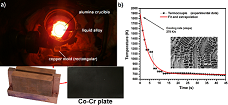
Antonio Zuorro
Sapienza University of Rome, Italy
Title: An enzymatic-based process for the extraction of fibers from diss stems with for composites reinforcement
Time : 14:20-14:40

Biography:
Antonio Zuorro is a Professor of Biochemical Engineering Fundamentals and Chemical Engineering for BioMedical Systems in the Department of Chemical Engineering Materials and Environment of Sapienza University of Rome. He received his MS and PhD degrees in Chemical Engineering from Sapienza University of Rome. His research activity has been mainly focused on the development of innovative chemical and biotechnological processes for the recovery of high value-added compounds from by-products and agro-industrial residues, such as lycopene from tomato waste and phenolic antioxidants from artichoke and bilberries waste, olive pomace and coffee grounds. He also examined the possibility of including the extracts obtained in consumer food products to get new functional foods with high antioxidant activity. In the field of enzyme technology, he studied the use of multi-enzyme systems with enhanced activity for the recovery of lipids and bioactive compounds with high added value from microalgae. He is the author of over 60 scientific publications and several industrial patents, ranging from the biochemical extraction of valuable compounds to the fibers recovery for material applications.
Abstract:
The diss plant (Ampelodesmos mauritanicus) is an herbaceous perennial plant of the family Gramineae that lives on arid and sandy soils, typical of Mediterranean grassland. The species is widespread in North Africa, in coastal areas of Spain, France, Balkan, Turkey and Italy (in particular, on the arid coastal slopes of the Center-South, in Sicily and in the coastal region of Liguria). Its stems are composed of cellulosic filaments linked by lignin, pectins and hemicellulose. Short fibers can be obtained from the stems by aggressive extraction methods which eliminates the binders. They can be used for paper production. On the other hand, the extraction of long and flexible fibers, useful for the production of reinforcement of composites, is not yet developed and is therefore the subject of this work. Stems were treated with 0.25 M KOH in autoclave at 140ºC for 1 h in order to remove lignin, in the presence of 1.5% of sodium hydrosulfite used as reducer agent. Delignified stems were then treated with different enzymes (pectinases, xylanases and a mixture of them) for pectin and hemicelluloses removal. This treatment was performed at 50ºC, pH 4.5 for 1 h. The effect of enzymatic treatments on the morphological, chemical composition and mechanical properties of diss fibers was investigated and the effectiveness of enzymatic treatments has been evaluated. The results indicate that the tensile properties of fibers were greatly improved when an optimized enzymatic-based process was used to separate the fibers from the stems. This work also showed that enzymes offer an attractive and eco-friendly approach to extract plant fibers.
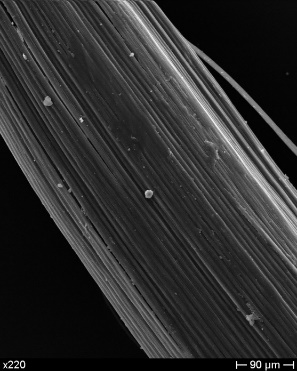
Damia Mawad
University of New South Wales, Australia
Title: Flexible and soft bioelectronics for the biotic/abiotic interface
Time : 14:40-15:00

Biography:
Damia Mawad has been appointed a lecturer at the School of Materials Science and Engineering, UNSW Australia in August 2015 after completing her Marie Curie International Incoming Fellowship in Imperial College London, UK. From 2008 to 2012, she was a Research Fellow at the Intelligent Polymer Research Institute, University of Wollongong. Her research interests are in polymeric biomaterials applied in tissue engineering. One of her main investigations is development of electroactive and conductive scaffolds for biomedical applications with emphasis on material chemistry and design strategies that transition from a monomer to a polymer to 3D construct. Examples include conductive porous hydrogels that induce cell attachment, proliferation and differentiation and conductive bioadhesives for cell alignment and photoadhesion to tissue. Recent research output in Science Advances on how to manipulate the cardiac conduction velocity after a heart attack was featured in international news outlets attesting to the novelty of the investigations.
Abstract:
Statement of the Problem: Damaged electroresponsive tissues such as spinal cord injuries and myocardium infarctions malfunction due to disruption in the bioelectric signal propagating along the tissue. Flexible and soft organic bioelectronics are being explored as biomaterial-based approaches applied on the biotic/abiotic interface to electro-couple with the tissue and restore the electric signal. However, the clinical application of organic conducting polymers (CPs) has been mainly hindered by their short term operational lifetime in physiological conditions and their hydrophobicity that impedes nutrients transfer needed for cell survival. Furthermore, fixing these flexible bioelectronics on soft tissue can be challenging and requires invasive suturing techniques. The purpose of this research is to develop novel bioelectronics with tailored chemistries that address the aforementioned limitations with proven electrophysiological effect on electroresponsive tissues such as the heart. Methodology: By manipulating the chemistry of conjugated backbones, conductive constructs such as a hydrogel doped with large polyelectrolyte or free standing patch doped with small anion were fabricated. The chemical components of the patch permitted adhesion to tissue by light activation. In vitro and in vivo experiments were conducted to investigate how these conductive scaffolds interact with tissues. Findings: New generation CPs were synthesized with demonstrated biocompatibility and ease of processability. The conductive hydrogel is demonstrated to be a suitable 3D hydrated network that promotes the proliferation of C2C12 muscle cells and exhibits electroactivity in physiological media (Fig. 1A). The patch is shown to have an extended electronic biostability, adheres to tissue without the need of sutures and electro-couple with infarcted cardiac tissue enhancing the conduction velocity of the electric signal across scar tissue (Fig. 1B). Conclusion & Significance: By modifying the chemistry of CPs, these macromolecules could be fine-tuned into functional materials opening the way for the development of novel multifunctional bioelectronics capable of electro- coupling with biological tissues.
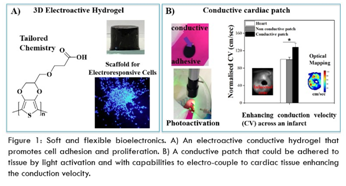
Jorge Macanás de Benito
Polytechnic University of Catalonia, Spain
Title: Strategies for enhancing interfacial adhesion between chicken feather filler and thermoplastic matrices in biocomposites
Time : 15:00-15:20

Biography:
Macanás J is an Associate Professor in the Department of Chemical Engineering at Universitat Politècnica de Catalunya. His present research is mainly focused on Materials Science and Nanotechnology. He has developed some metal-polymer nanocomposites with different configurations for environmental and catalytic applications. He is currently working on the valorization of several industrial residues as materials with approaches such as the reported here.
Abstract:
Statement of the Problem: Millions of tons of chickens are sacrificed every year for meat production generating at the same time a proportional amount of animal byproducts (ABPs) not intended for human consumption. Among these ABPs, chicken feathers (CFs) represent around 5-7% of the total chicken weight and currently are mainly treated as a waste by landfilling and/or incineration. During last year’s there has been an interest to valorize CFs to obtain value-added products such as biocomposites, biosorbents, filter media, insulation materials and tissue engineering scaffolds. However, in the case of biocomposites, it was demonstrated that mixing CFs with thermoplastic matrices was not effective in terms of mechanical properties due to the lack of compatibility between the components. So, the purpose of this study was to apply methods for improving mechanical properties of CFs based biocomposites by promoting interfacial adhesion between CFs and polyolefinic matrices. On one hand, some functionalizing treatments such as silanization and acetylation were performed to CFs and, on the other hand, a partial substitution of the matrix by adhesion promoters, such as maleic anhydride modified polymers (MAPs) was proposed. The effect of such modifying strategies on the mechanical properties was studied.
Methodology & Theoretical Orientation: CFs were stabilized by an oxidative treatment. After that, fractions of the CFs were treated with methacryloxypropyltrimethoxysilane and with acetic anhydride for their silanization and acetylation, respectively. Treated CFs were used to prepare biocomposites by mixing 20% v/v of CFs with either PP or LDPE in a Brabender mixer. Alternatively, biocomposites were prepared by substitution of polymer matrices with MAP adhesion promoter (Fusabond® P613 or M603, DuPont, USA). Tensile tests were carried out to determine mechanical properties.
Findings: Silanization and acetylation did not improve the mechanical properties of biocomposites. However, the incorporation of MAPs additive causes an improvement of tensile strength of the biocomposite (see image for PP).
Conclusion & Significance: Mechanical properties of CFs thermoplastic biocomposites were improved using MAPs which enhance the interfacial adhesion between CFs and polyolefinic matrices.
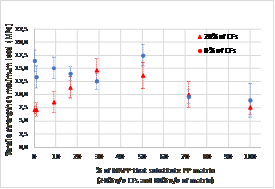
Hong Yee Low
Singapore University of Technology and Design, Singapore
Title: Geometry and size dependent structural reversibility of sub-micrometer polymer structures
Time : 15:20-15:40

Biography:
Hong Yee Low received her education in the field of Polymer Science and Engineering from Case Western Reserve University, Cleveland, USA. In the past 15 years, her research interests and activities have been in nanofabrication of polymeric structures and in the studying the surface properties of micro- and nanoscale surface patterns. In her research, nano-imprint process has been the primary fabrication technique used for creating a variety of complex, quasi 3-dimensional micro- and nanoscale surface patterns. Biomimicry is also an approach she has adopted in developing novel surface structures and functionalities. The surfaces developed by her research group have been applied in applications ranging from electronics, biomedical and optical devices.
Abstract:
Highly uniform, sub-micrometer surface patterns have been actively investigated as non-chemical means of surface engineering. Surface functionalities such as wetting, friction and optical effects can be engineered through a variety of micrometer and nanometer surface patterns; such functionalities are greatly influenced by geometries and length scales of the surface patterns. Changes to the geometry and the sizes of the surface pattern can result in changes in the associated surface functionalities or have implications on the durability of the surface functions. In this study, a systematic quantification of the mechanical deformation and the recovery of nanoimprinted sub-micrometer polymers have been conducted. Shape memory polymers Nafion and polyurethane acrylate (PUA) were programmed with permanent shape memories of the surface patterns via high temperature nano-imprinting. Surface patterns ranging from 2 micrometer to 200 nm were investigated under uniaxial tension and compression. The geometrical deformation and recovery of the surface patterns were quantified using atomic force microscopy (AFM). A schematic methodology employed in this study is shown in figure-1. Geometrical deformation and recovery were found to be dependent on the pattern size, aspect ratio and geometries (isotropic versus anisotropic, protrusion versus recess structures). A transition in deformation mechanism was also found to be dependent on the size and aspect ratio of the structures (figure 2). Understanding the mechanical deformations of these surface patterns is important towards achieving durable surface patterns, their functions and opens new opportunity for engineering active surface patterns.
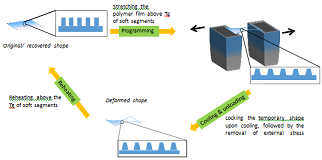
Thomas Fiedler
University of Newcastle, Australia
Title: Perlite metal syntactic foam (PMSF) in impact engineering
Time : 15:40-16:00

Biography:
Thomas Fiedler has completed his Master’s degree in Mechanical Engineering from the University of Erlangen-Nuremberg (Germany) in 2004. He continued his academic career at the University of Aveiro (Portugal). After completing his PhD in 2007, he started working as a Post-doctorate at the University of Newcastle, where he is currently working as an Associate Professor. He has research expertise in cellular materials (metals and ceramics) and composite materials, experimental and computational mechanics, finite element methods, Monte Carlo methods, and mechanical and thermal material testing.
Abstract:
Metallic foams exhibit a relatively constant deformation resistance during compression. As a result, they are highly attractive for impact engineering where controlled energy absorption and deceleration is required. Over the past decades, metallic foams have attracted growing interest due to their unique and multi-functional properties. However, to this date they have often failed to become a viable commercial solution. The key inhibitors are their high cost and the variability of mechanical properties. Perlite metal syntactic foam (PMSF, see Fig. 1) is a novel material that has the potential to overcome both limitations. It combines inexpensive raw materials (i.e., expanded perlite particles and standard casting alloys) with a close control of geometry and hence mechanical properties. In the presented study, PMSF is probed for its suitability as the energy absorbing element of an automotive crash cushion. In the first step, the desired material properties are derived from the permissible forces during the impact. In the following, the mechanical properties of PMSF are tailored to meet these requirements. This is achieved by increasing the perlite volume fraction and selecting pure aluminum as the metallic phase. To prevent the likelihood of global buckling a PMSF cylinder is selected as the energy-absorbing element. The component is tested both numerically and in a 2.5 tons drop test that replicates the forces occurring during an automotive impact.
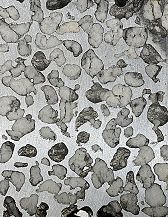
Kanchan Mondal
Southern Illinois University, USA
Title: Synthesis and characterization of titanium carbide nanofibers using a modified carbothermal reduction process
Time : 16:25-16:45

Biography:
Kanchan Mondal has her expertise in process and materials development and conducts research to find holistic solutions for a sustainable energy future.
Abstract:
Statement of the Problem: Single phase titanium nanofiber synthesis is a challenge. In this paper, the synthesis of titanium carbide nanofibers using a carbothermal process will be presented along with the thermal, mechanical and electrical properties.
Methodology & Theoretical Orientation: Titanium oxide nanofibers were fabricated by electrospinning method from a sol containing a mineral acid for peptizing, followed by calcination at temperatures ranging from 250-800ºC. Various carbothermal routes of production of these high L/D structures will be shown and the impact of processing routes on the morphology will be discussed. One route involved the coating of carbon on the oxide nanofibers by cracking of propylene (C3H6). Carbon coated titania fibers were reacted at 1400ºC and 1500ºC for 1 or 2 hours under argon atmosphere to form titanium carbide nanofibers. The titanium carbide nanofibers were characterized using scanning electron microscope (SEM), transmission electron microscope (TEM and HRTEM), and X-ray diffraction (XRD).
Findings: The average diameter of the TiO2 fibers and TiC fibers averaged at 150 nm and 350 nm, respectively. Due to the high conductivity, chemically and electrochemical stability in strong acid and high potential environment, the synthesized TiC fibers show great potential for fuel cell applications such as support of bipolar plates and catalyst support. The data also show the potential EDLC applications of these fibers. The electrical, mechanical and thermal properties of the synthesized TiC will be reported and compared with the theoretical values.

David Lokhat
University of KwaZulu-Natal, South Africa
Title: Highly dispersed zinc based sorbents for hot gas desulphurization: Synthesis and application
Time : 16:45-17:05

Biography:
David Lokhat is the Head of the Reactor Technology Research Group of the School of Engineering at the University of KwaZulu-Natal in Durban, South Africa. His research interests are in catalysis and reactor engineering, specifically process intensification, high temperature processes and applications in fluorochemistry. In 2013, he received the South African Institute of Chemical Engineers Innovation Award for the development of a novel continuous process to produce a fluorochemical intermediate.
Abstract:
Most hydrocarbon fuels like petroleum, natural gas and coal contain other elements in small quantities which, after high-temperature processing, are transformed into various impurities. These impurities include compounds of sulphur. Conventional methods of desulphurization involve absorption of the acid component using regenerative solvents moving counter currently with the fuel derived gas in an absorption column. Desulphurization may also be accomplished using solid sorbents such as metal oxides. This study focused on the enhancement of sulphur removal capacity and regeneration characteristics of solid mesoporous zinc-based sorbents through ultrasound assisted dispersion of active components. The investigation attempted to determine if sonication during wet impregnation of the prepared precursor materials would yield a sorbent with highly dispersed metal oxide content and if the improved dispersion would result in enhanced sorbent capabilities. ZnO/SiO2 sorbents using the wet impregnation technique were prepared using a ZnCl2 precursor solution. The efficacy of the prepared sorbents was tested for hot gas desulphurization using a high temperature flow-through apparatus. A synthetic coal gas was used. Experiments were conducted at temperatures of 350-500ºC and space time of 67500 h-1. Breakthrough curves for H2S absorption were constructed from temporal measurements of the H2S concentration in the exit gas stream, using a gas chromatograph equipped with a flame photometric detector. Sonicated sorbents had comparably better desulphurization breakthrough times (on average a 50% increase) than non-sonicated sorbents. It was confirmed that the sorbents prepared via the ultrasonic-assisted impregnation technique had enhanced breakthrough times and saturation capacities.

Ali Kalkanli
Middle East Technical University, Turkey
Title: Melt infiltration casting of alumina, silicon carbide and boron carbide reinforced aluminium matrix composites
Time : 17:05-17:25

Biography:
Ali Kalkanlihas has his expertise in processing of aluminum, magnesium alloys and metal matrix composites. He completed his MS thesis on metal powder atomization at METU Turkey and PhD thesis on melt overflow stainless steel strip casting processing in Milton Keynes at Open University, England. Alloy development and various casting and metal processes are his main interest areas.
Abstract:
A series of metal matrix composites were produced using 7075 and 7085 aluminum alloys as matrix alloys and Al2O3, SiC and B3C4 seramic preforms. Melt infiltration casting was performed with a vertical squeeze caster applying 70 ton pressure during processing. Sintering of ceramic preforms were carried out at 1000, 1100 and 1300ºC for one hour then preheated hot sintered preforms at 1000ºC were placed into a die cavity before aluminum infiltration casting. During processing vertical 70 ton and upward 40 ton hold down pressure was applied for three minutes for melt infiltration. Mechanical characterizations were done by three point bending tests and flexure strength values obtains for 7075 alloy infiltrated Al2O3 preforms as 520-600 MPa.
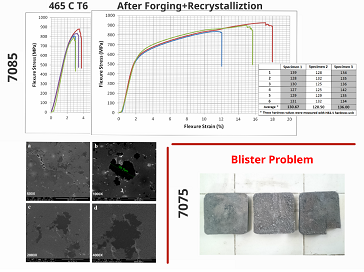
Rahul Madathiparambil Visalakshan
University of South Australia, Australia
Title: Biomaterial surface modification to control inflammation: Effect of nanotopography and surface chemistry on protein adsorption and cell response
Time : 17:25-17:40

Biography:
Rahul M Visalakshan is pursuing his PhD in Biomaterial Engineering and Nanomedicine from School of Engineering University of South Australia. He is working on his thesis titled “Surface Engineered Biomaterials to Control Inflammation”. He has won Australian Post-graduate Award Scholarship to pursue his PhD. He is a graduate from University of East London, UK where he received his Master’s in Biotechnology and Management. He completed his Bachelor’s in Biotechnology from Mahatma Gandhi University, India.
Abstract:
Biomaterial surface nanotopography and chemical functionalities have been shown to play a critical role in modulating the host immune response. Studies have demonstrated that the effect of surface characteristics are translated through the surface adsorbed protein layer to the immune cells. Recently, various techniques have been developed to create surfaces with nanotopography to control protein and cell responses. Most of these studies attempted to produce nanotopography by etching the surface to incorporate pores, grooves, and pillar structures. However, inconsistent topography, chemical functionalities and lack of reproducibility resulted in conflicting reports. Therefore, we developed a technique that can produce well-defined and reproducible topography to identify the role of specific roughness size, height, density and presence of homogeneous chemical functionality. Using plasma polymerization of oxazoline monomers and immobilized gold nanoparticles, we created surfaces with an equal number density of nanoparticles of different sizes. This surface was used to study the role of surface nanotopography and the interplay of surface chemistry on proteins and cells. Effect of nanotopography on fibrinogen adsorption was investigated using quartz crystal microbalance with dissipation and the mass of fibrinogen adsorbed were decreased on surfaces with increasing nano-topography. Cell responses such as adsorption and proliferation were studied using human dermal fibroblasts.
Samaneh Pourmohammadimojaveri
Western Sydney University, Australia
Title: High performance rubber concrete
Time : 17:40-17:55

Biography:
Samaneh Pourmohammadimojaveri joined the Western Sydney University in 2014, as a PhD research student. She Her PhD research has been focused on developing a framework for optimum use of recycled materials such as waste tyre rubber in concrete construction
Abstract:
For centuries, the researchers have been trying to make life easier for everyone, all the achieved technologies in material, civil, mechanical, chemical, electrical and other fields of engineering are appreciated and valued. Many scientists worked on how to get to the next level of development in all areas during the last decades, and as a result of that mankind enjoys a better life these days. But achieving all these developments without concern for the environment has resulted in some serious environmental damages such as global warming, stockpiling solid wastes in outdoor areas, fire, disease and poisoning.
Nowadays, to resolve the said problems all over the world, there are several organizations focused on manufacturing and distributing sustainable and recycled products such as recycled tyre rubber, and etc. Also there are some market leaders in delivering sustainable products to customers in Civil Infrastructure, Building and Construction, Transport and other industries. But still the problem is standing and it seems the progress is rather slow. To reduce the resulting environmental impacts is for researchers to propose new products considering not just the scientific benefits, but also addressing sustainable development as a major concern more than ever in their projects.
The current research is based on using recycled wastes such as vulcanized rubber of used- tyres and trying to turn them into value added materials to achieve better quality. These recycled materials in some concrete applications after being modified chemically in order to obtain a product with enhanced physical, mechanical, thermal and structural properties, will decrease the impact of these waste materials on the environment. Due to high demand for concrete and its applications in all countries, the outcome of this research could make a big change in construction materials and technology for the future.
Burak Cagri Ocak
Istanbul Technical University, Turkey
Title: Investigation of the microstructure and oxidation properties of NbB2-SiC-GNP composites
Time : 17:55-18:10
Biography:
Burak Cagri Ocak has a Bachelor’s degree in Metallurgy and Materials Engineering from Istanbul Technical University. He also received his Master’s degree in Materials Engineering and did his thesis work on ultra-high temperature ceramics. Currently, he is pursuing his Doctoral education from the Istanbul Technical University.
Abstract:
Niobium diboride (NbB2), ceramic is characterized by an excellent combination of properties comprising high melting point, hardness, wear resistance, thermal conductivity, good creep resistance, and excellent chemical stability. However, difficulties in densification, low fracture toughness and poor oxidation resistance of NbB2 limit the use of these materials. A number of studies have shown that addition of SiC improves the oxidation resistance by forming a protective SiO2-rich layer and improve fracture toughness of transition borides. Moreover, recent studies have demonstrated that graphene nano-platelets (GNP) addition can significantly enhance the mechanical properties of ceramic matrices. In this study, GNPs were incorporated into (20-x)SiC-80NbB2 (vol.%) composite powder with x=0, 0.5, 3, 5, 7 and 10 vol.% contents. The resulting powder mixtures were sintered by spark plasma sintering (SPS) at 1750ºC under 50 MPa with a 5 min holding time. The sintered composites were then characterized with respect to their densification, microstructure, oxidation behavior and mechanical properties change with the combination of SiC and graphene nano platelets. Improvement in oxidation resistance as a result of formation of protective layers and fracture mode change with the incorporation of SiC and GNPs will be discussed in this presentation.
